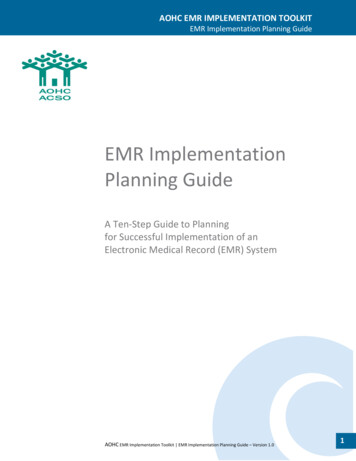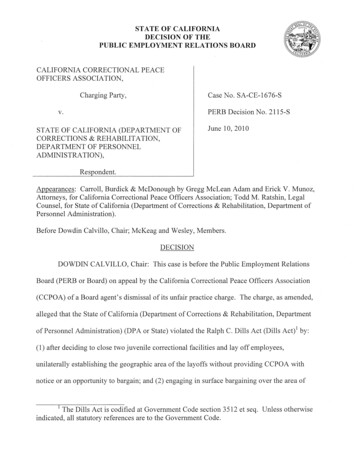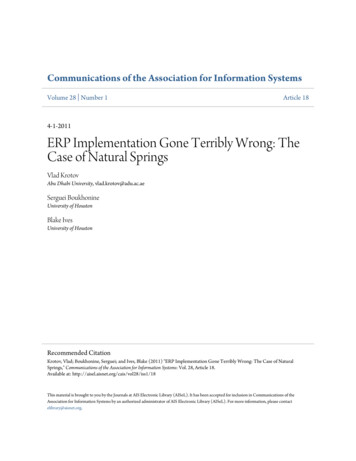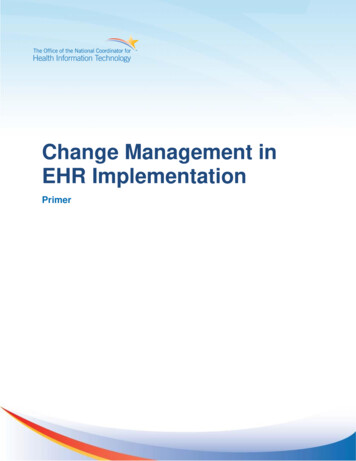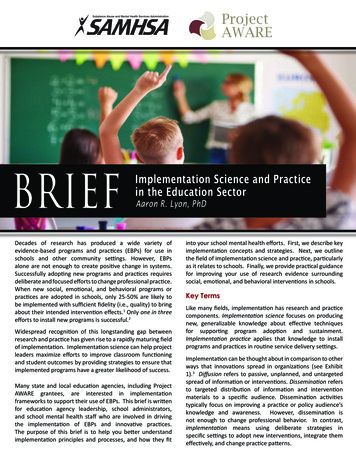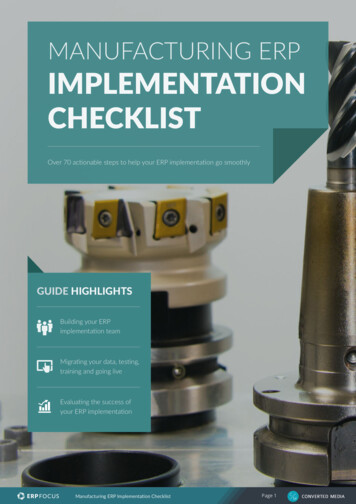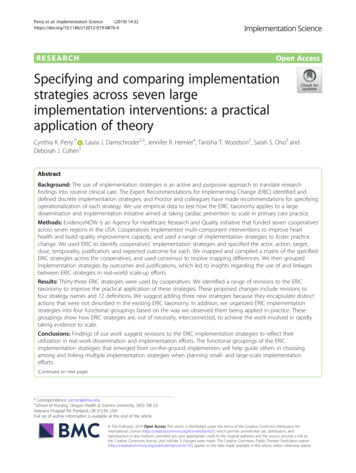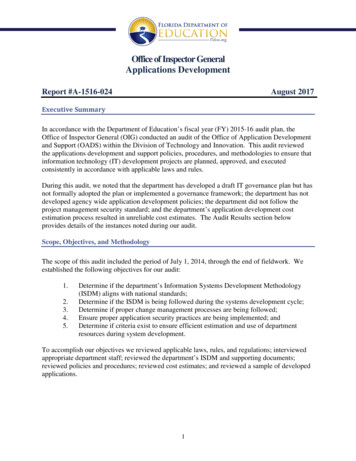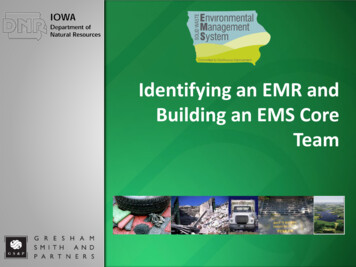
Transcription
Soffe et al. BMC Health Services Research(2021) EARCH ARTICLEOpen AccessDevelopment and implementation of apatient assistance fund: a descriptive studyBurke W. Soffe* , Justine E. Miranda, Jenny Fang, Daniel G. Epperson, Roberto A. Lara, Hazel L. Williamson andMartin S. LipskyAbstractBackground: The purpose of this descriptive study is to outline the Roseman University of Health Sciences (RUHS)College of Dental Medicines’ Patient Assistance Fund development, organization and outcomes. The descriptionand reported results provide insight to others considering similar health professions programs.Methods: The Patient Assistance Fund (PAF) affords dental students an opportunity to petition for and obtainfinancial assistance for their most disadvantaged patients. In this study, two sources of data were collected andused with a quantitative analysis for data collected as part of the PAFs operation and a qualitative analysis toevaluate the patient experiences.Results: A total of 16 student advocates, consisting of 6 males and 10 females from the D3 and D4 classes made26 presentations to the PAF board committee. The combined amount requested from the PAF was 47,428.00(“Cost of Treatment Plan”) representing an average request per patient of 1824.15 (range 324.00 to 4070.00). Theapproved procedures and treatment plans totaled 21,278.36 (“Cost of Approved Procedures”) with an average of 818.40 (range 204.00 to 2434.00) per patient. Patients and students expressed a high degree of satisfaction withthe program.Conclusions: This study provides an overview of the structure, funding sources, expenditures and patient servicessupported by a dental student managed patient assistance fund. The experiences at RUHS College of DentalMedicine (CODM) suggest that other healthcare professions schools can develop similar type programs that yieldbenefit both to students and to patients in need.Keywords: Health professions education, Access to care, Dental care, Oral health, Patient assistance fund, Patientoutcomes assessment, Financial barriersBackgroundThe significant improvement in the oral health of Americans over the past 50 years is a public health successstory [1]. However, striking disparities in dental diseaseand access to care still exist in the United States. Amongthe barriers to care, financial limitations remain themost significant obstacle [2–4]. Global statistics link access to regular dental care directly to annual income [5].* Correspondence: bsoffe@roseman.eduCollege of Dental Medicine, Roseman University of Health Sciences, 10895 S.River Front Pkwy, South Jordan, UT 84095, USAIn the US, a 2020 Surgeon General’s report noted thatsocioeconomic factors are significant risk factors forpoor oral health and poverty increases the likelihood oftooth loss. In addition, individuals living in poverty account for the highest percentage of people who did notget dental care due to cost [6, 7]. According to Vujicicet al., 59% of adults who had not visited the dentistwithin the past 12 months cite cost as the reason, morethan any other type of health care [4]. Risks of delayingoral health care can lead to needless pain, increased timeoff from school or work, advanced dental disease The Author(s). 2021 Open Access This article is licensed under a Creative Commons Attribution 4.0 International License,which permits use, sharing, adaptation, distribution and reproduction in any medium or format, as long as you giveappropriate credit to the original author(s) and the source, provide a link to the Creative Commons licence, and indicate ifchanges were made. The images or other third party material in this article are included in the article's Creative Commonslicence, unless indicated otherwise in a credit line to the material. If material is not included in the article's Creative Commonslicence and your intended use is not permitted by statutory regulation or exceeds the permitted use, you will need to obtainpermission directly from the copyright holder. To view a copy of this licence, visit http://creativecommons.org/licenses/by/4.0/.The Creative Commons Public Domain Dedication waiver ) applies to thedata made available in this article, unless otherwise stated in a credit line to the data.
Soffe et al. BMC Health Services Research(2021) 21:14including untreated caries, periodontal disease, andtooth loss [8]. Evidence suggests that marginalized patients often seek treatment in emergency departmentsfor problems that might have been prevented given access to adequate oral health care [9].Dental schools, as safety net facilities, offer a more affordable option for dental care when compared to private practice dental offices [10]. As a result, it is notsurprising that the economically disadvantaged are themost frequently reported special population receivingcare at dental school clinics in the United States [11].However, even with reduced costs, some patients stillcannot afford even the most simplified and less costlytreatment plans [12].In 2017, a group of students at Roseman Universityof Health Sciences (RUHS) College of Dental Medicine (CODM) in South Jordan, Utah wanted to improve access at the CODM student clinic by reducingfinancial barriers to care. To achieve this goal, thestudents searched for ideas from models used at otherinstitutions such as the dental student founded andmanaged club at Oregon Health Sciences Universitydesigned in 2013 “to change the way underservedpopulations interact with the world by empoweringpatients to manage their own health through directdental health promotion” [13]. RUHS students thenapproached the CODM and University leadership withthe concept of creating their own student managedPatient Assistance Fund (PAF) to provide financial assistance to the clinic’s most financially vulnerable patients. Proposed program goals were 4-fold: Provide assistance to dental patients “of record” atRoseman University College of Dental Medicine(CODM) clinic Alleviate financial barriers and improve access todental care Cultivate a humanistic and person-centered care approach by allowing student dentists to identify andadvocate for patients in financial need Enhance student education and clinical experienceBy lowering the financial burden of dental care, thestudent managed PAF helps indigent patients achieve alevel of oral health that would otherwise not be unattainable. Under the guidance of a faculty mentor, student dentists advocate to a group of their peers forpatients who would otherwise refuse treatment due tocost. This advocacy role fosters an open dialogue between student dentists and patients regarding treatmentneeds, oral health, and access to care. Peer group decisions regarding financial awards also give students anappreciation and skills regarding maximizing limitedresources.Page 2 of 8The purpose of this descriptive study is to outline theRUHS CODM PAF’s development, organization andoutcomes. To our knowledge, this represents the firstpublished comprehensive description and associatedoutcomes of a dental student-driven patient assistancefund. The description and reported results should provide insight to others considering similar programs.MethodsIRB statementThe study protocol was reviewed and approved by theRoseman University of Health Sciences Institutional Review Board with an assigned study number of 1,513,182.SettingRoseman University of Health Sciences (RUHS) is a private, nonprofit health sciences university with campusesin Nevada and Utah. RUHS offers degrees in nursing(BSN), dentistry, pharmacy, and a master’s in businessadministration as a dual degree with pharmacy and dentistry. All programs are fully accredited and employ amastery-based model, using criteria and curriculum relevant to their discipline. RUHS College of Dental Medicine’s (CODM) undergraduate dental program is locatedin South Jordan, Utah, part of the Salt Lake City metropolitan area. The CODM i
Roseman University of Health Sciences Institutional Re-view Board with an assigned study number of 1,513,182. Setting Roseman University of Health Sciences (RUHS) is a pri-vate, nonprofit health sciences university with campuses in Nevada and Utah. RUHS offers degrees in nursing (BSN), dentistry, pharmacy, and a master's in business
